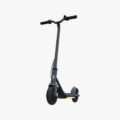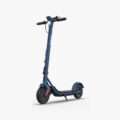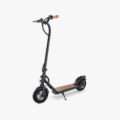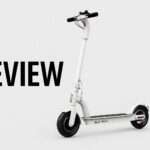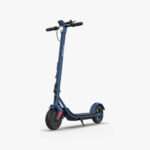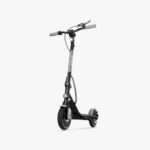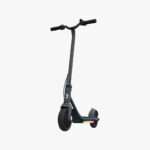- Home
- Scooters
- Electric Scooters
- Jetson Racer
Jetson Racer


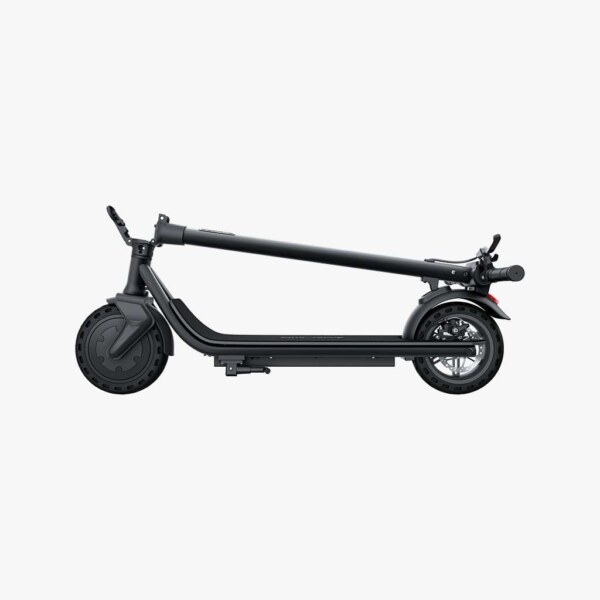

- Battery Range: 16 miles (26 km)
- Top Speed: 15.5 mph (24.9 km/h)
- Motor Power: 250 W
- Weight Capacity: 220 lb (100 kg)
- Charging Time: Approx. 5 hours
- Scooter Weight: 34.5 lb (15.6 kg)
PROS
- 15.5 mph (24.9 km/h) top speed with 16 mile (26 km) range
- 250 W motor and 7.5 Ah battery for longer rides than some Jetson models
- 8.5 in solid tires with rear disc brake
- Cruise control and multiple speed modes
- Foldable design with taller handlebar for adults
CONS
- Solid tires transmit bumps and vibrations
- 34.5 lb (15.6 kg) weight is less portable
- Limited hill climbing despite 15° rating
- No app connectivity or water resistance rating

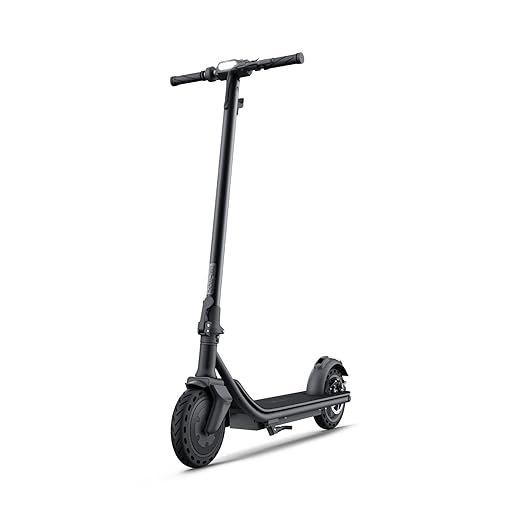
Key Takeaways
- The Jetson Racer is a compact electric scooter designed for easy daily commutes and casual rides.
- It features a 250 watt motor, a 36 volt lithium ion battery, and offers a top speed of 15.5 mph with a range of up to 16 miles.
- The scooter is lightweight at 31 lbs and easily foldable, making it portable for storage and travel.
- Its solid tires and mechanical disc brakes provide a reliable ride, while the simple controls suit new riders.
- The Jetson Racer is ideal for short, flat trips but may struggle on steep hills or lengthy routes.
Table of contents
- What Is the Jetson Racer?
- How the Jetson Racer Works
- Key Specifications
- Design & Build Quality
- Performance Fundamentals
- Battery, Range & Efficiency
- Ride Quality & Comfort
- Braking & Safety Features
- Portability & Daily Usability
- Maintenance & Care
- Weather & Seasonal Considerations
- Jetson Racer vs Alternatives
- Who the Jetson Racer Is (and Isn’t) For
- Practical Tips for New Owners
- A Quick Note on Fit and Expectations
The Jetson Racer is a compact electric scooter built for simple daily rides. It keeps things light, foldable, and friendly, so new riders get comfortable fast. City commuters, students, and casual riders who want a no-drama way to move around settle into it quickly.
If you are comparing across the Jetson lineup, the Jetson Eris sits as a lighter, agile option. And the Jetson Eris Pro steps things up for riders who want more headroom.
What Is the Jetson Racer?
The Jetson Racer is an adult folding e-scooter with a straightforward setup and clean look. It runs a 250 watt front hub motor, a 36 volt lithium ion battery, and a thumb throttle with three speed modes. Top speed sits at 15.5 mph (25 km/h), which matches what many riders feel safe with on bike paths and neighborhood streets. Range is rated up to 16 miles (25.7 km) on one full charge, which covers short commutes, campus runs, or everyday errands.
Solid 8.5 inch tires help avoid flats from glass or small debris. A cable driven rear disc brake handles stopping. An LCD display shows speed, mode, and battery level at a glance. There is a USB charging port on the handlebar area for topping up small devices. The frame folds at the stem and locks down toward the deck, so you can carry or store it without much fuss.
The scooter targets riders aged 12 and up with a listed load limit of 220 lb (100 kg). At about 31 lb (14.1 kg), it stays manageable for short carries up stairs or into a trunk. The deck gives enough length for a natural staggered stance. The cockpit layout is simple, so you figure it out in a few minutes, not days. Its core specifications lean toward easy use instead of raw power, which fits its role.
How the Jetson Racer Works
The Jetson Racer keeps the ride controls simple. Hold the power button, wait for the screen, then pick a speed mode. Give a light push, press down on the thumb throttle, and the front hub motor pulls you forward. More pressure on the throttle, more current from the controller. That direct link makes the scooter feel easy to read. It comes off the line in a smooth, gentle way, which helps in tight spaces and around people.
The 36 volt, 7.5 amp hour battery sits inside the deck and stores the energy for your rides. You can picture it as a small fuel tank feeding the electric motor. The controller meters how much power goes to the motor based on your thumb. Cruise in mode two with a steady hand, and you stretch your distance. Spend most of the ride pinned in mode three, and you trade some range for higher speed.
Braking uses a hand lever that controls the rear mechanical disc. Pull the lever, pads clamp the rotor. The feel is direct, with the bite coming about halfway through the pull. That makes it easy to time stops and modulate pressure. Solid tires add one more layer of daily peace of mind, since you do not wake up to slow leaks. Cruise control kicks in after holding a steady throttle for a short stretch, then keeps your speed on long straights so your hand can relax.
Key Specifications
This table collects the core specifications in a quick view, with imperial units first and metric in brackets.
| Item | Value |
|---|---|
| General | |
| Model | Jetson Racer |
| Recommended Rider Age | 12+ |
| Rider Weight Limit | 220 lb (100 kg) |
| Product Weight | 31 lb (14.1 kg) |
| Performance & Power | |
| Motor | 250 W front hub |
| Top Speed | Up to 15.5 mph (25 km/h) |
| Max Range | Up to 16 miles (25.7 km) |
| Climbing Angle | Up to 15° |
| Speed Modes | 3 modes |
| Battery, Charging & Electrical | |
| Battery | 36 V, 7.5 Ah lithium ion (about 270 Wh) |
| Charging Time | Up to 5 hours |
| Charger Output | 42 V, 1.5 A |
| Display | LCD screen |
| USB Port | Yes, on handlebar area |
| Build & Dimensions | |
| Wheel Size | 8.5 in (21.6 cm) |
| Tire Type | Solid tires |
| Deck Size | 28.5 x 6.5 in (72.4 x 16.5 cm) |
| Unfolded (L x W x H) | 42.3 x 18.5 x 46.3 in (107.4 x 47.0 x 117.6 cm) |
| Folded (L x W x H) | 42.3 x 18.5 x 17.7 in (107.4 x 47.0 x 45.0 cm) |
| Safety & Control | |
| Brake | Rear mechanical disc hand brake |
| Throttle | Thumb throttle |
| Bell | Yes |
| Lights | Front and rear lights |
| Water Resistance | Marked as water resistant |
| Features & Extras | |
| Cruise Control | Yes |
| Kickstand | Yes |
| USB Charging | Yes |
| Warranty & Compliance | |
| Warranty | 1 year limited |
| Compliance | Check local regulations |
Design & Build Quality
The Jetson Racer looks like a classic city scooter, just powered. The stem is straight, the deck is long and clean, and most of the wiring runs tucked away. The front hub motor keeps the rear of the scooter simple. The rear disc brake, fender, and kickstand sit in a compact cluster that is easy to inspect.
Up front, the LCD sits in the center, and the thumb throttle and brake lever sit close to the grips. This setup makes sense the first time you step on. The display is basic yet clear, which is what you want in bright daylight. Speed, battery, and mode are easy to scan without staring down for long.
The deck length gives enough room for a natural staggered stance, which helps comfort on longer rides. Grip tape covers the standing area and holds up under dusty shoes. Panel gaps stay small, and the latch hardware feels steady in normal use. Fold the stem down, hook it, lift. The motion turns into muscle memory after a day or two. Nothing flashy, just a simple, tidy build that lines up with its numbers.
Performance Fundamentals
The Jetson Racer will not snap your head back, and that fits its class. The 250 watt front hub gives a gentle launch that feels friendly for new riders and teens. In mode one, it rolls at a walking to light jogging pace. Mode two covers relaxed city cruising. Mode three lets you reach that 15.5 mph (25 km/h) top speed on flat ground.
Once up to pace, the scooter feels stable for its size. The long deck and low center of gravity help. Steering stays predictable if you keep both hands on the bar and your weight centered or slightly back. On smooth pavement, holding top speed feels calm. On broken asphalt, it makes sense to ease down a bit, which matches the wheel size and solid rubber.
On hills around 7 to 10 percent, the Jetson Racer slows and works harder, especially for riders near the 220 lb (100 kg) limit. Short climbs are fine if you keep some rolling speed going in. Long, steep streets are not its strong point. Think of it as a scooter tuned first for flat or mildly rolling routes in town.
Battery, Range & Efficiency
The 36 V, 7.5 Ah pack gives about 270 Wh of capacity. The claimed range of up to 16 miles (25.7 km) makes sense for a light to mid weight rider on flat paths who spends time in the lower modes. Real life adds variables. Rider size, frequent stops, rough ground, headwinds, and cold weather all shave distance.
Plan around a practical 8 to 12 mile window for mixed riding with some full throttle. If you weigh less, ride smoother paths, and favor mode two, you can land closer to the claim. If you sit near the weight limit and hold mode three a lot, expect less. That clear view of the numbers keeps expectations honest.
You stretch range with a few simple habits. Use lower modes in crowded areas, then step up on open stretches. Hold a steady pace instead of constant full squeeze and release. Coast early toward red lights so you brake less. Keep the deck, hubs, and solid tires clean to reduce drag.
Charging from low to full takes up to five hours. Plug the charger into the wall first, then into the scooter. Let it reach full, then unplug. Do not leave it sitting on charge for days. And let the scooter cool or warm toward room temperature before charging after very hot or very cold use.
Ride Quality & Comfort
Solid 8.5 inch tires cut out punctures but pass more of the road feel to your feet. On clean bike lanes and fresh pavement, the ride feels smooth and quiet. On rougher streets, you notice taps from cracks and joints through the deck. The scooter stays in control, yet it reminds you this is a light commuter without spring suspension.
You improve comfort a lot with stance. Stand with one foot forward, one back, knees bent, arms loose. Shift your weight a bit back over bumps so the front wheel does not hit as hard. That soft posture turns sharp hits into smaller movements. The long deck lets you slide your feet until it feels right.
Handlebar height works for many riders in the mid height range. Taller riders can ride with a light bend in the elbows. Shorter riders still reach controls without stretch. Grips feel basic yet secure. The overall feel invites two hands on the bar, which suits the design.
Braking & Safety Features
Stopping power comes from the rear mechanical disc brake. Lever feel is clear, and braking builds in a steady way. Start with a light pull, then add more if you need a harder stop. On dry pavement, the setup fits the speed range well.
On wet streets or dusty patches, start braking earlier. Keep weight centered or a touch back so the rear tire holds grip. Solid rubber behaves differently on wet paint or metal covers, so smooth input wins over sudden grabs.
The Jetson Racer includes front and rear lights for basic visibility. Use them in the evening or in lit city areas. For dark routes, many riders will want a brighter add-on headlight and a stronger rear flasher. Side reflectors, reflective ankle bands, or a bright jacket make a real difference at intersections. The bell does its job on shared paths.
The frame and deck design, plus water resistant build, handle light splashes. Avoid deep puddles and standing water. Electronics and motors never enjoy that for long.
Portability & Daily Usability
Portability is one of the easy wins here. At about 31 lb (14.1 kg), it is not ultra light, yet most people can lift it with one hand for short stretches. Folding takes a quick release at the stem, a drop toward the deck, and a hook. Once folded, it fits a trunk, hallway corner, or under desk spot without drama.
This helps a lot for mixed commutes. Ride from home to the bus or train, fold, carry on, then open it again for the last part. At the office or on campus, it stays out of the way. The kickstand helps with fast stops outside stores.
Solid tires keep daily checks fast. No air pump routine. You still look over the tread, clear sharp debris, and listen for odd sounds. The LCD makes it easy to time charges around your day, since battery bars are clear on screen.
For security, treat it like a small bike. Bring it inside when possible. If you must lock outside, loop a strong lock through the frame and a fixed point, and avoid leaving it for long hours.
Maintenance & Care
Maintenance on the Jetson Racer stays friendly.
Before or after every few rides
- Check the stem latch for full lock and no play.
- Squeeze the brake lever and confirm the bite comes before the grip.
- Look over the solid tires for cuts or stuck debris.
Every two weeks
- Check bolts on stem, deck, and brake mount and snug any that moved.
- Inspect the brake cable near the lever and caliper for fraying.
- Spin both wheels and see if anything rubs the rotor or fender.
Every two months
- Check brake pad thickness and replace pads that look thin.
- Wipe the frame with a damp cloth and dry it.
- Look along the wiring for pinches or cracked housing.
Battery care keeps it healthy. Try to stay roughly between 20 and 90 percent for daily use. Do not leave it empty for weeks. For storage longer than a month, park it around half charge and top up a little each month.
A small hex key set and basic wrench cover nearly everything here. No complex setup.
Weather & Seasonal Considerations
The Jetson Racer handles light wet use, but it feels best on dry ground. On damp roads, bring speed down, brake earlier, and use smoother steering. Painted lines, metal plates, and wet leaves turn slick quickly under solid tires. If rain turns heavy, pausing the ride is often the safer call.
Heat and cold both affect the battery. Very hot days speed up wear if you leave the scooter in direct sun or a closed car. Try to park in shade. Very cold days chop range. Start with a warm battery from indoors, ride with a gentler hand, and expect fewer miles.
Season changes bring grit and leaves onto paths. Give yourself more margin, use decent lights, and pick clothing that shows up well in low light.
Jetson Racer vs Alternatives
Think of three broad scooter groups. light commuters, bigger commuter models, and heavy performance machines. The Jetson Racer sits in the light commuter camp.
In that segment, its 250 watt motor, claimed 16 mile range, and solid tires match riders who want simple daily transport with low fuss. You get enough speed for real trips in town, quick folding, and a clean layout that matches its spec sheet.
Step up to larger commuter scooters and you get more battery, stronger motors, and higher cruising speeds. Those climb long hills better, yet they weigh more and feel less friendly to carry. Move to performance or off road models, and both weight and power jump, along with cost and upkeep.
So the Jetson Racer makes the most sense for flat to mild routes, short to mid length trips, and tight storage spaces. If that sounds like your pattern, it stays on target.
Who the Jetson Racer Is (and Isn’t) For
A good match for
- Riders with about 2 to 6 miles each way on mostly flat ground.
- Students who move between classes and dorms and want quick folding and easy storage.
- Commuters who mix scooter rides with bus or train legs.
- New riders, teens, or careful adults who prefer calm power over hard hits.
- Apartment dwellers who need a scooter that fits under desks or into closets.
Not the best choice for
- Long daily routes above 10 to 12 miles without a mid day charge.
- Steep hill zones where grades near 10 percent go on for blocks.
- Riders who expect soft suspension comfort on rough streets.
- People who want 20 mph or higher cruise speeds.
- Heavy cargo use or riding with a second person.
If your ride plan stays short, smooth, and under those limits, the Jetson Racer feels like an easy fit. If your roads run longer, steeper, or rougher, you step beyond what it is built to do.
Practical Tips for New Owners
- Start in mode one or two until throttle feel becomes natural.
- Keep both hands on the bar and both feet on the deck while moving.
- Use cruise control on clear, straight paths. tap the brake or throttle to exit.
- Store and charge indoors in a dry, cool place.
- Do quick visual checks often instead of waiting for a big issue.
These small habits stack up to smoother rides and fewer surprises.
A Quick Note on Fit and Expectations
Every rider brings different height, weight, and routes. If you are close to the 220 lb (100 kg) limit, expect slower climbs and a bit less range than the claim. If your path is flat and under 5 miles each way, this scooter lines up well. If you carry it up stairs every day, try that lift at 31 lb (14.1 kg) in real life and see how it feels.
Match your daily routes, hills, and storage space with what the Jetson Racer offers. When those pieces line up, you get a simple, low stress electric scooter that does its job without making a big fuss.
Specifications
General
| Model The Model specifies the exact version or name of the scooter. It helps identify its unique design, features, and specifications within the manufacturer’s product line. Knowing the model makes it easier to compare options, find compatible accessories, or look up support information. | Racer |
| Brand The Brand identifies the manufacturer or company that designs and produces the scooter. A trusted brand is a sign of quality, reliability, and good customer support. Well-known brands often have higher standards for safety, performance, and after-sales service, giving you more confidence in your purchase. | Jetson |
| Release Date The Release Date indicates when the scooter model was officially launched on the market. This helps you know how current the design, technology, and features are. A newer release date often means updated components, improved performance, and the latest safety or smart features. | 18 November 2025 |
| Recommended Age Recommended Age indicates the minimum age range that the scooter is designed for, based on safety, size, and ease of use. Following the recommended age helps ensure that riders can handle the scooter’s speed, weight, and controls comfortably and safely. Always check local laws and use protective gear, especially for younger riders. | 12+ |
Performance & Power
| Motor Power (Wattage) What it means: The motor power, measured in watts (W), shows how strong the scooter’s electric motor is. Why it matters: Higher wattage usually means better acceleration, more torque, and improved performance on hills or rough terrain. For example, a 250W motor is good for flat city roads and light riders, while a 500W or 1000W motor provides more power for faster speeds or climbing steep inclines. | 250 W hub motor |
| Top Speed The Top Speed indicates the maximum speed that the scooter can reach under optimal conditions. It’s usually measured on level ground with a fully charged battery and an average rider weight. A higher top speed allows you to travel longer distances faster, but always ensure you ride within legal speed limits and your personal comfort zone for safety. | 15.5 mph (24.9 km/h) |
| Battery Capacity Battery Capacity refers to the total amount of energy the scooter’s battery can store, usually measured in ampere-hours (Ah) or watt-hours (Wh). A higher battery capacity means you can ride longer distances on a single charge, reducing the need for frequent recharging. Keep in mind that actual range can vary depending on rider weight, terrain, speed, and weather conditions. | 36 V 7.5 Ah (270 Wh) |
| Estimated Range per Charge The Estimated Range per Charge indicates the average distance the scooter can travel on a single full battery charge. This range is calculated under optimal conditions, such as flat terrain, moderate speed, and average rider weight. Real-world range may vary depending on riding style, terrain, weather, and load. A longer range means fewer recharges and greater freedom for longer trips. | 16 miles (26 km) |
| Hill Climb Ability Hill Climb Ability describes the maximum incline or slope that the scooter can handle while maintaining stable performance. It’s typically expressed as a percentage or in degrees. A higher hill climb rating means the scooter can tackle steeper hills without losing too much speed or power. Actual climbing performance may vary based on rider weight, battery charge, and terrain conditions. | 15° (~27% grade) |
| Drive System The Drive System refers to how power from the motor is delivered to the wheels. Electric scooters typically use either a hub motor (directly integrated into the wheel) or a chain/belt drive system. A high-quality drive system ensures smooth acceleration, efficient power transfer, and low maintenance. The choice of drive system affects performance, noise level, and overall ride experience. | Rear hub (RWD) |
Charging & Electrical
| Charging Time Charging Time indicates how long it takes to fully recharge the scooter’s battery from empty to 100% using the standard charger provided. Faster charging means less downtime and more time on the road. Actual charging time may vary slightly depending on battery capacity, charger output, and environmental conditions. | Approx. 5 hours |
| Battery Type Battery Type refers to the specific technology used in the scooter’s battery, which affects performance, lifespan, weight, and charging time. Most modern electric scooters use high-quality lithium-ion (Li-ion) batteries because they offer a good balance of energy density, durability, and low maintenance. A reliable battery type ensures consistent power delivery and longer riding ranges. | 36 V 7.5 Ah lithium-ion battery |
| Removable Battery A Removable Battery means the battery pack can be easily detached from the scooter for convenient charging and replacement. This feature allows you to charge the battery separately, swap it with a spare for extended range, or securely store it indoors in extreme weather. Removable batteries add flexibility and make it easier to keep your scooter powered up wherever you are. | Non-removable internal battery |
| Regenerative Braking Regenerative Braking is an energy-saving feature that converts some of the energy normally lost during braking back into battery power. When you slow down or brake, the motor works in reverse to generate electricity, which helps extend the scooter’s range and improves overall efficiency. This system also reduces wear on traditional brake components, leading to lower maintenance over time. | Not specified |
| Lighting Lighting refers to the built-in front and rear lights that enhance visibility and safety when riding in low-light conditions or at night. Good lighting helps you see the road ahead and ensures that other road users can see you. Many scooters include LED headlights, taillights, and sometimes brake lights or side reflectors for added safety and compliance with local traffic regulations. | LED headlight |
Build & Dimensions
| Scooter Weight Scooter Weight refers to the total weight of the scooter when fully assembled, including the battery. This affects how easy it is to carry, lift, and store the scooter when not in use. A lighter scooter is more portable and convenient for commuting, especially if you need to carry it upstairs or onto public transport. Keep in mind that a sturdy frame and quality components may add to the weight but also contribute to better durability and ride stability. | 34.5 lb (15.6 kg) |
| Maximum Rider Weight Maximum Rider Weight indicates the highest rider weight that the scooter is designed to safely support while maintaining optimal performance and stability. Staying within this limit helps ensure reliable acceleration, braking, and climbing ability, and it protects the frame, suspension, and motor from excessive strain. Exceeding the recommended limit may reduce performance and increase wear on components. | 220 lb (100 kg) |
| Deck Size Deck Size refers to the dimensions of the scooter’s standing platform. A wider and longer deck provides more foot space, allowing you to stand comfortably and adjust your stance while riding. A well-sized deck improves balance and stability, especially on longer rides or at higher speeds. Compact decks, on the other hand, help keep the scooter lightweight and portable. | Larger deck and taller stem for stable ride |
| Handlebar Height Handlebar Height refers to the distance from the deck to the handlebars, which affects your riding posture and comfort. An appropriate handlebar height helps you maintain good balance, reduces strain on your back and arms, and makes steering more comfortable. Some scooters have adjustable handlebars to fit riders of different heights, while others have a fixed height for a streamlined design. | Fixed height 46.3 in (117.6 cm) |
| Folding Mechanism The Folding Mechanism describes how easily and securely the scooter can be folded for carrying and storage. A well-designed folding system lets you quickly collapse the scooter into a compact size, making it convenient to transport on public transit, store under a desk, or fit into a car trunk. Look for sturdy latches and safety locks to ensure the scooter stays firmly in place when folded or unfolded. | Foldable frame with locking latch |
| Dimensions Folded Dimensions indicate the size of the scooter when it’s fully folded. This measurement shows how much space the scooter will take up when stored or carried, making it easier to check if it will fit in your car trunk, under a desk, or in a closet. Compact folded dimensions are ideal for commuters who need to bring their scooter on public transport or store it in tight spaces. | Unfolded: 42.3 x 18.5 x 46.3 in (107.4 x 47.0 x 117.6 cm); Folded: 42.3 x 18.5 x 17.7 in (107.4 x 47.0 x 45.0 cm) |
| Material Material refers to the primary construction materials used for the scooter’s frame and key components. High-quality materials like aircraft-grade aluminum, reinforced steel, or durable composites provide strength, stability, and a lighter overall weight. A sturdy material ensures the scooter can handle daily wear and tear while maintaining safety and performance. | Aluminum alloy |
Safety & Control
| Brake Type(s) Brake Type(s) describe the braking systems the scooter uses to help you slow down or stop safely. Common brake types include mechanical brakes (like drum or disc brakes), electronic brakes, and foot brakes. Many scooters combine multiple braking systems for added safety and shorter stopping distances. The type and quality of brakes affect your control, especially when riding at higher speeds or on slopes. | Rear disc brake |
| Suspension Suspension refers to the system that absorbs shocks and vibrations while riding, providing a smoother and more comfortable ride over uneven or rough surfaces. Scooters may have front suspension, rear suspension, or dual suspension for better shock absorption and stability. Good suspension helps reduce rider fatigue and improves control, especially when riding on bumpy roads or off-road paths. | None |
| Tire Type Tire Type refers to the kind of tires the scooter uses, which directly affects ride comfort, traction, and maintenance. Common types include solid (airless) tires, pneumatic (air-filled) tires, or hybrid options. Pneumatic tires offer better shock absorption and a smoother ride on rough surfaces, while solid tires are puncture-proof and require less upkeep. The right tire type helps ensure safe handling and a comfortable ride in different conditions. | 8.5 in solid tires |
| Tire Size Tire Size indicates the diameter and width of the scooter’s tires, which affect ride comfort, stability, and how well the scooter handles different terrains. Larger tires generally offer better shock absorption and a smoother ride over bumps and rough surfaces, while smaller tires keep the scooter lighter and more portable. Choosing the right tire size helps ensure a balance between agility and comfort. | 8.5 in |
| Kickstand The Kickstand is a built-in stand that allows you to park your scooter upright when it’s not in use. A sturdy kickstand keeps the scooter stable and prevents it from tipping over, protecting it from scratches and damage. It also makes storing and accessing your scooter more convenient, whether you’re at home, work, or on the go. | Side kickstand |
| Water Resistance Rating Water Resistance Rating indicates how well the scooter is protected against water and moisture, usually shown as an IP (Ingress Protection) rating. This rating helps you understand whether the scooter can handle light rain, splashes, or wet roads without damage. While most scooters are not fully waterproof, a good water resistance rating adds peace of mind when riding in changing weather conditions. Always avoid deep puddles or submerging the scooter to protect its electrical components. | Not specified |
Features & Extras
| Display/Console The Display (or Console) shows important real-time information about your ride, helping you monitor your scooter’s status at a glance. Typical displays show speed, battery level, distance traveled, and riding mode. Some models also include additional features like Bluetooth connectivity, app integration, or backlighting for better visibility at night. A clear and easy-to-read display enhances safety and convenience on every trip. | LCD display |
| Ride Modes Ride Modes refer to the different speed and power settings you can choose to match your riding style or road conditions. Common modes include eco for maximum range and energy efficiency, standard for everyday balance, and sport or turbo for higher speed and stronger acceleration. Switching between ride modes allows you to customize performance, conserve battery, and ride safely in various environments. | 3 speed settings |
| Smart App Connectivity Smart App Connectivity lets you pair your scooter with a dedicated mobile app via Bluetooth. Using the app, you can monitor real-time ride stats like speed, battery level, and range, adjust settings such as ride modes or cruise control, lock the scooter for added security, and sometimes receive firmware updates. This feature adds convenience and allows you to personalize your riding experience right from your smartphone. | No dedicated app |
| Anti-Theft System The Anti-Theft System helps protect your scooter from unauthorized use or theft. This feature can include built-in alarms, electronic motor locks, GPS tracking, or remote locking through a mobile app. A good anti-theft system provides peace of mind when parking your scooter in public spaces, adding an extra layer of security to safeguard your investment. | Bell and controls; no lock |
| Cruise Control Cruise Control allows you to maintain a steady speed without continuously holding the throttle. This feature makes longer rides more comfortable by reducing hand fatigue and providing a smoother, more relaxed riding experience — especially on flat, open roads or bike lanes. For safety, cruise control can usually be easily activated or deactivated while riding. | Yes |
| Accessories Included Accessories Included lists the additional items that come with the scooter to enhance your riding experience and convenience. Common accessories may include a charger, kickstand, bell, lights, phone holder, or carrying strap. These extras add value by making your scooter safer, easier to use, and ready to ride straight out of the box. | Racer scooter, charger, user manual |
Warranty & Compliance
| Warranty Period The Warranty Period indicates how long the manufacturer guarantees the scooter against defects in materials and workmanship under normal use. A good warranty provides peace of mind, showing the brand’s confidence in its product quality. Always check what parts are covered, such as the frame, battery, and motor, and follow the maintenance guidelines to keep your warranty valid. | 180 days limited warranty |
| Certifications Certifications confirm that the scooter meets specific safety, quality, and environmental standards set by recognized organizations or regulatory bodies. Common certifications may include CE, RoHS, UL, or other local compliance marks, depending on your region. These certifications ensure that the scooter is manufactured to high standards and is safe and legal to use in your country. | Region-dependent; follow local micromobility regulations |
Price Comparison




